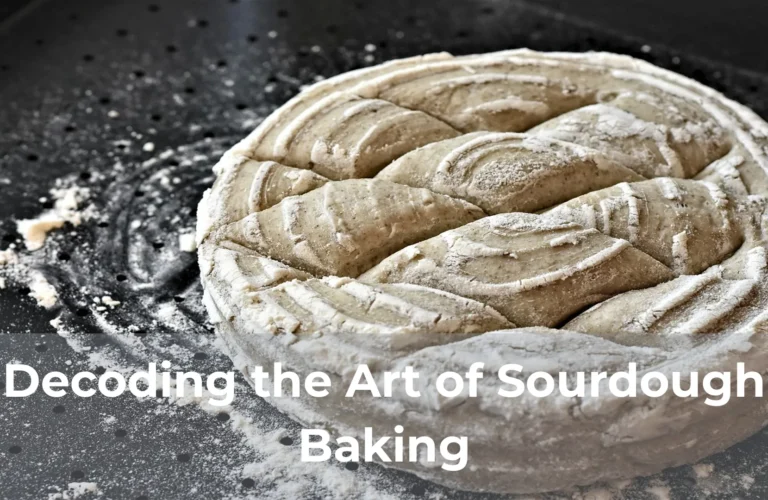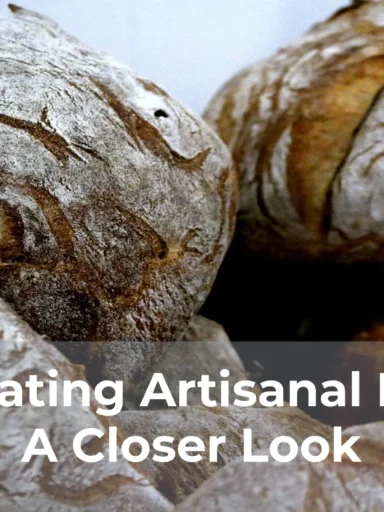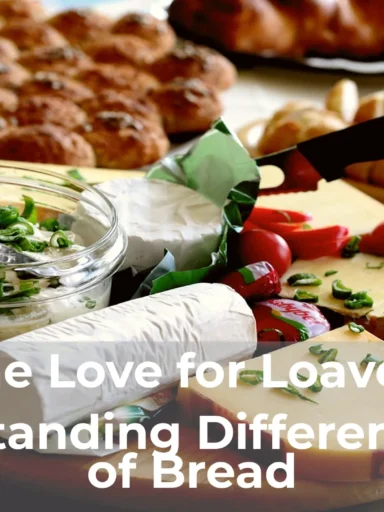Decoding the Art of Sourdough Baking
Decoding the Art of Sourdough Baking
Sourdough bread has been captivating taste buds for centuries, but what is the secret behind its unique flavor and texture? In this article, we delve into the fascinating world of sourdough baking, exploring the science and artistry behind creating the perfect loaf. From understanding the fermentation process to mastering the intricate dance between flour, water, and wild yeasts, we unlock the mysteries of sourdough and share tips and tricks for achieving bakery-worthy results in your own kitchen. Whether you’re an experienced baker or a curious novice, join us on this journey as we unravel the hidden secrets of sourdough baking and discover how to elevate your bread-making skills to new heights.
The Rise and Resurgence of Sourdough Bread
Over the past few years, sourdough bread has experienced a remarkable resurgence in popularity. Once a traditional bread reserved for artisan bakers and hardcore bread enthusiasts, sourdough has now made its way into mainstream culture. From social media feeds filled with beautifully baked loaves to trendy cafes offering sourdough toast, it seems that everyone is jumping on the sourdough bandwagon. But what is the reason behind this rise in popularity, and why has sourdough bread become the new culinary trend?
The Science Behind Sourdough Fermentation
Sourdough bread has been a culinary staple for centuries, known for its distinct flavor and chewy texture. But have you ever wondered how this delicious bread gets its unique characteristics? The answer lies in the fascinating process of sourdough fermentation.
At its core, sourdough fermentation is a symbiotic relationship between yeast and lactic acid bacteria. In the first stage, the yeast, naturally present in the environment or added to the dough, metabolizes the carbohydrates in the flour, producing carbon dioxide gas and alcohol. This process is known as alcoholic fermentation and is responsible for the rise of the dough. Simultaneously, the lactic acid bacteria consume the sugars in the dough and produce lactic acid through a process called lactic acid fermentation. The lactic acid gives sourdough bread its characteristic tangy flavor.
Understanding the Health Benefits of Sourdough
Sourdough bread has gained popularity in recent years, not just for its unique tangy flavor, but also for its numerous health benefits. Unlike conventional bread, which is made using commercial yeast, sourdough is leavened by wild yeast and lactic acid bacteria, resulting in a fermentation process that brings various advantages to the table. Firstly, sourdough is easier to digest than regular bread, thanks to the presence of lactic acid bacteria that break down gluten and other complex proteins. This makes it a favorable choice for those with gluten sensitivities or digestive issues. Additionally, the fermentation process increases the bioavailability of nutrients, making sourdough rich in vitamins and minerals, such as B vitamins, iron, and zinc. Furthermore, sourdough has a lower glycemic index compared to conventional bread, leading to more stable blood sugar levels and better overall blood sugar control. With its unique taste and impressive health benefits, sourdough is definitely worth considering as a healthy and delicious addition to your diet.
Unveiling the Complexity of Sourdough Starter
Unveiling the Complexity of Sourdough Starter
Discover the intricate world of sourdough starter as we delve into its fascinating origins, composition, and role in the art of breadmaking. This seemingly simple mixture of flour and water is much more than meets the eye. From the natural fermentation process to the symbiotic relationship between yeast and bacteria, we’ll unravel the intricacies that make sourdough starter such a key element in creating the perfect loaf of bread. Join us on this exploration of flavor, science, and tradition as we uncover the hidden secrets behind this humble yet essential ingredient.
The Role of Time and Temperature in Sourdough Baking
When it comes to baking the perfect loaf of sourdough bread, time and temperature play critical roles in achieving that tangy, chewy, and flavorsome result. Sourdough bread, known for its distinct taste and texture, is made through a process of fermentation where wild yeasts and lactic acid bacteria interact with flour and water. The time and temperature during each step of the sourdough baking process can greatly influence the flavor, texture, and rise of the final product.
One of the primary factors to consider in sourdough baking is the time it takes for the dough to undergo fermentation. Fermentation allows the dough to develop complex flavors and a light, airy structure. The longer the fermentation period, the more pronounced the sourdough flavor becomes. However, the duration of fermentation should be carefully balanced to avoid over-fermentation, which can result in a sourdough that is overly acidic or dense. Additionally, the temperature at which the dough ferments can impact the speed at which the fermentation process occurs. Higher temperatures can accelerate fermentation, while lower temperatures slow it down. Finding the right balance between time and temperature is crucial to achieving the desired taste and texture in sourdough bread.
The Secret Ingredients That Make Sourdough Unique
Sourdough bread has been a beloved staple for centuries, with its distinct tangy flavor and chewy texture that sets it apart from other breads. But what exactly gives sourdough its unique qualities? The answer lies in its secret ingredients – wild yeast and lactic acid bacteria. Unlike commercial yeast used in most breads, sourdough relies on natural fermentation to rise and develop its characteristic taste and texture.
Wild yeast, also known as sourdough starter, is the key player in the souring process. It consists of a mixture of flour and water that captures wild yeast naturally present in the environment. Once combined, this mixture undergoes fermentation, allowing the wild yeast to multiply and convert the carbohydrates in the flour into carbon dioxide gas. It is this gas that creates the bubbles and airy texture in sourdough bread. Additionally, the wild yeast produces organic acids, such as lactic and acetic acid, which contribute to the distinct tangy flavor of sourdough.
Exploring the Art of Sourdough Shaping and Scoring
Sourdough bread has become a beloved staple among home bakers, and it’s not just the taste that makes it so special. The art of shaping and scoring sourdough loaves is an integral part of the baking process, allowing bakers to create beautiful, artisanal bread with their own unique touch. In this article, we delve into the world of sourdough shaping and scoring, exploring the techniques, tools, and tips that can help you elevate your bread-making skills to another level.
Shaping sourdough is an art form that requires patience and practice. The process involves gently stretching and folding the dough to create tension, which gives the bread its characteristic shape and crumb structure. Different techniques, such as the boule (round) or batard (oval), can be used to shape the dough, each lending its own aesthetic appeal. Once the dough is shaped, the scoring comes into play. Scoring is the act of making deliberate cuts on the surface of the dough, not only to create an aesthetically pleasing pattern but also to control the expansion of the bread during baking. Join us as we explore the fascinating world of sourdough shaping and scoring, and unlock the secrets to creating visually stunning, delicious loaves that will impress friends and family alike.
Mastering the Art of Sourdough Baking at Home
Mastering the Art of Sourdough Baking at Home
There’s something truly magical about the process of baking sourdough bread. The combination of flour, water, and naturally occurring wild yeast creates a unique flavor profile and a beautiful, crusty loaf that is both satisfying to make and delightful to eat. But sourdough baking is not just about the end result; it’s a journey of patience, precision, and understanding the intricacies of fermentation. In this article, we will dive into the world of sourdough baking, exploring the key techniques and tips to help you become a master bread maker in your own home.
From Novice to Pro: Tips for Perfecting Sourdough
Are you a novice baker looking to perfect your sourdough bread? Look no further! In this article, we will share some valuable tips and techniques that will help you become a pro at making the perfect sourdough loaf. Whether you’re new to baking or have been experimenting with sourdough for a while, these tips will surely elevate your skills and take your bread to the next level.
First and foremost, understanding the sourdough process is key to achieving consistent and delicious results. Sourdough baking is a symbiotic relationship between flour, water, and wild yeast. To ensure a strong and active starter, it is crucial to maintain a regular feeding schedule and proper hydration. By keeping your starter healthy, you’ll have a reliable foundation for your bread-making endeavors.
Another important aspect of sourdough perfection is the fermentation process. Patience is paramount here. Allowing the dough to ferment at a controlled temperature for an extended period helps develop complex flavors and a beautiful crumb structure. Experiment with different fermentation times and temperatures, and observe how these variables affect the final product. With time and practice, you’ll learn to master the art of fermentation and produce exceptional sourdough bread every time.
Frequently Asked Questions (FAQ)
How do you read sourdough?
Reading sourdough is about understanding the language of fermentation, observing its rise and fall, listening to the crackling crust, and savoring the complex flavors that tell the story of time, patience, and mastery in baking.
How do you score sourdough design?
Sourdough design is scored based on aesthetics and technique. The design should be visually appealing with well-defined cuts, while also considering how the scoring affects the bread’s rise and crust development.
How do you know when sourdough is done baking?
To know when sourdough is done baking, look for a golden crust, hollow sound when tapped on the bottom, and an internal temperature of 200-210°F.
Why is it so hard to score my sourdough?
Scoring sourdough bread dough can be tricky due to its high hydration level, strong gluten development, and the need for precise technique. Practice, patience, and experimentation are key to achieving those beautiful, artistic slashes.




